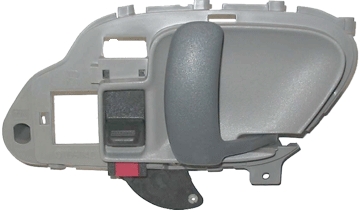1995 Chevrolet Silverado 1500
Contents
C1500 versus K1500
The difference between a K1500 and a C1500 is that the K1500 is 4 wheel drive and the C1500 is 2 wheel drive. Both GMC and Chevrolet designate the vehicles in this way. 1500 is the designation for the 1/2 ton pickup truck. 2500 designates a 3/4 ton pickup truck and so on. Both GMC and Chevrolet have used these designations for years. Although they used to call the half ton two wheel drive pickup truck a C10. The 3/4 two wheel drive a C20 and so on. The K series is used to designate the 4 wheel drive pickup trucks. Thus a K1500 is a 1/2 ton 4 wheel drive pickup truck and so on.
Interior Body Parts
1995-2000 Chevrolet Silverado inside door handle
 DOOR HANDLE, FRONT, PASSENGER SIDE, INSIDE, GRAY -- A High Quality, Direct Fit OE Replacement For Door Handle.
DOOR HANDLE, FRONT, PASSENGER SIDE, INSIDE, GRAY -- A High Quality, Direct Fit OE Replacement For Door Handle.
- Fits all 1995-1999 Chevrolet C1500 -- 1995: 6Cyl 4.3L Base, 1995: 8Cyl 5.0L Base, 1995: 8Cyl 5.7L Base, 1995: 6Cyl 4.3L Cheyenne, 1995: 6Cyl 4.3L Silverado, 1995: 6Cyl 4.3L WT, 1995: 8Cyl 5.0L Cheyenne, 1995: 8Cyl 5.0L Silverado, 1995: 8Cyl 5.0L WT, 1995: 8Cyl 5.7L, Cheyenne, 1995: 8Cyl 5.7L Silverado, 1995: 8Cyl 5.7L WT
- GMC Pickup PU Truck C/K series & Suburban, Yukon, Tahoe , RIGHT HAND (passenger side) for the following years and models: 1995 1996 1997 1998 1999 2000 2001 2002
- SKU: C462159, iDH1018R
- OEM: 15708044
- O'Reilly: 77186
- $15.99 @ http://www.oreillyauto.com/EW3/ProductDetail.do?itemNumber=77186
- $16.99 @ http://www.directauto.com/product-exec/product_id/1878/nm/1995_2000_Chevrolet_Silverado_1500_1995_2000_Chevrolet_Silverado_1_2_ton_RH_gray_inside_door_handle
- $18.93 @ http://www.car-stuff.com/carparts/chevroletc150019951999replacementc4621591.html
Mechanical Troubleshooting
Engine temperature exceeds normal operating range, fluctuates erratically, or overheats
The thermostat is a critical part of the cooling system that fails the most frequently. Thermostats are cheap, and when they fail they tend to be sluggish to open causing the engine temperature to exceed normal operating range, sometimes up to 240 degrees and in other cases the thing will stick closed and cause the engine to overheat.
- Thermostat
- Low coolant
- Water pump
- Other possibilities include low oil, bad engine, etc...
No Heat from heater or insufficient heat to defrost windows and warm cab
1. Check thermostat
- Typically when the thermostat fails it is stuck in the closed position, causing the engine to overheat, making plenty of hot water available to the heater core. In some rare examples the thermostat can get stuck open, preventing the engine from reaching the normal operating temperature of [ 185 degrees F (need to verify temperature) ].
2. Low on coolant
- If there is insufficient coolant in the radiator you will likely notice an abnormally low reading on the dash gauge. In the event of a leak in the radiator, hoses, or part of the cooling system the level of coolant may fall below the point where there is sufficient liquid to circulate though the heater core.
3. Heater valve
- (need to verify fact: vacuum controlled valve with vacuum leak will not open and circulate coolant though heater core?)
4. Clogged heater core
- (need to verify) flush heater core one direction then the other. flush the cooling system using a back-flush kit. check dampers to ensure functional. (Does this truck have a vaccuum cut off valve?)
- Check the heater hoses that run to the heater core to determine if one is significantly warmer than the other.
!warning! When attempting to disconnect hose from heater core, it is easy to damage the heater core by pulling too hard or twisting on the hose at the connection. Antifreeze sometimes causes the hose material to bond with the metal fitting making them extremely difficult to remove the hoses. Use care on the delicate heater core fitting.
